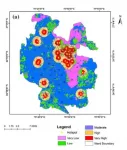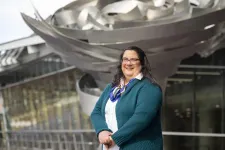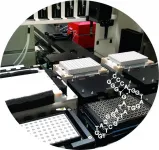Mapping COVID risk in urban areas: a way to keep the economy open
Researchers in India use GIS mapping to identify city neighborhoods at highest risk of a COVID outbreak--helping officials place targeted restrictions to avoid an economic shutdown
2021-03-26
(Press-News.org) As COVID-19 vaccines slowly roll out across the world, government officials in densely populated countries must still manage vulnerable communities at highest risk of an outbreak.
In a new study published in the Journal Risk Analysis, researchers in India propose a COVID Risk Assessment and Mapping (CRAM) framework that results in a zoned map that officials can use to place more targeted restrictions on high-risk communities. Successfully used by officials in Jaipur at the peak of the pandemic last spring, their framework could help other vulnerable countries avoid a shutdown of their regional economies.
Led by Shruti Kanga, associate professor in the Centre for Climate Change and Water Research at Suresh Gyan Vihar University, the team used satellite remote sensing and Geographic Information Systems (GIS) technology to conduct a spatial risk assessment of the city of Jaipur, located in the state of Rajashthan.
Jaipur had been experiencing a rapid increase in COVID-19 cases since the first cases of the virus were diagnosed in India in January 2020. Due to its high population density, the Jaipur area was subject to extended lockdowns. "It became imperative for the authorities to manage lockdowns without affecting the state's economy," the authors write.
The researchers developed CRAM to provide officials with a vulnerability assessment-based lockdown strategy. Their risk-mapping method involves three steps: 1. Generating GIS layers of administrative, hazard, socio-economic, and bio-physical data. 2. Integrating hazard and vulnerability to generate risk assessment. 3. Risk mapping using an area's "boundary zones" for prioritizing risk areas and leading to prompt action. The final result is a GIS map of an area with color-coded risk zones delineating the neighborhoods at highest risk of a COVID outbreak.
CRAM generates a risk assessment by integrating hazard and vulnerability components associated with COVID. In the case of Jaipur, this data included these vulnerability risks: total population, population density, and availability of clean water for sanitation. Hazard risks included proximity to COVID "hotspots" (areas with a high density of confirmed positive cases) and land use/land cover--pinpointing high risk settlements and agriculture, where people gather and get exposed to the virus.
Data for each of these factors were used to create a GIS layer for the final map. GIS gives researchers the ability to layer unrelated data points on top of one another to reveal trends via visual maps. "Pandemics are a spatial phenomenon," says Suraj Kumar Singh, a co-author and professor in the Centre for Sustainable Development at Suresh Gyan Vihar University. "Their spread and lethality can only be understood holistically using GIS tools."
The researchers established five levels of "risk" zones: red, orange, blue, green, and pink (from highest to lowest risk). The level of risk was determined by multiplying hazard by vulnerability. The resulting color-coded map for Jaipur depicted significant spatial variation -- indicating that most areas under high-risk red and orange zones were concentrated along the northeastern and southwestern zones of the study area.
After consulting with authorities managing COVID-19 in the area, the researchers listed specific guidelines for the areas under each risk category. For example, closing shops in red zones; allowing shops to be open three days a week in blue zones; and allowing shops to be open five days a week in green zones. "In Jaipur, our CRAM helped local authorities in deciding which areas to put under lockdown," says Singh.
Highly populated countries of Asia--India, Bangladesh, and Pakistan-- have been especially vulnerable to COVID-19 because of their poverty, population densities, and weak health care systems. Some parts of India are currently experiencing a second wave of COVID-19, including the state of Maharashtra, home to the bustling city of Mumbai. Singh suggests that the CRAM framework could be used in any densely populated area with high-risk communities.
"The CRAM framework can be applied anywhere in the world," says Singh. "Researchers and decision-makers only need to change the parameters that are specific to that particular geographic region governing COVID-19 or any pandemic."
INFORMATION:
About SRA
The Society for Risk Analysis is a multidisciplinary, interdisciplinary, scholarly, international society that provides an open forum for all those interested in risk analysis. SRA was established in 1980 and has published Risk Analysis: An International Journal, the leading scholarly journal in the field, continuously since 1981. For more information, visit http://www.sra.org.
[Attachments] See images for this press release:

ELSE PRESS RELEASES FROM THIS DATE:
2021-03-26
An estimated 6 million Americans may suffer from peanut allergies. Tiny amounts of peanut protein can lead to hives, itching, tingling in the mouth, shortness of breath or nausea within minutes.
For individuals with severe peanut allergies, food-induced anaphylaxis can occur. It's a life-threatening emergency that requires treatment with an injection of epinephrine and a trip to the emergency room. Food labels offer warnings such as "may contain peanuts" or "was processed in a facility that may process nuts."
The warnings allow individuals with severe reactions to steer clear, but for consumers who may be able to tolerate a minimal amount of peanut protein without major incident the labels aren't very useful, says Lynne Haber, PhD, ...
2021-03-26
Women who suffer from vision, hearing or dual sensory loss are more than twice as likely to report depression and anxiety as men who experience the same issues, according to a new study by Anglia Ruskin University (ARU).
The research, which has been published in the International Journal of Geriatric Psychiatry, looked at survey data from more than 23,000 adults, where participants had self-reported whether they had suffered depression or anxiety, and also whether they experienced vision, hearing, or dual (both vision and hearing) sensory impairment.
Across the whole sample, the prevalence of depression ...
2021-03-26
So far, there has been little research into supportive care needs in patients with newly diagnosed incurable cancer and as their disease progresses. That is why experts from the German Cancer Society's working group on palliative medicine, led by Professor Florian Lordick, Director of the University Cancer Center Leipzig (UCCL), surveyed 500 patients between the ages of 25 and 89. What made the project special was the fact that the patients were accompanied from the moment they were diagnosed and before receiving any treatment. Professor Lordick sums it up thus: "There is an urgent need for patients to have early access to supportive palliative ...
2021-03-26
Usually, the different areas in the cerebrum take on a very specific function. For example, they process our movements or things we see or hear, i.e. direct physical information. However, some areas of the brain come into play when dealing with more advanced mental tasks. They process incoming information that has already been pre-processed and is thus already at an abstract level.
It was already known that the inferior parietal lobe (IPL) is one of these regions in the human brain. Nevertheless, it was unclear how this area is able to process such very different functions. In a large study, scientists from the Max Planck Institute for Human Cognitive and Brain Sciences (MPI CBS) in Leipzig and McGill ...
2021-03-26
During a normal waking state, information is processed and shared by various parts within our brain to enable flexible responses to external stimuli. Researchers from the University of Turku, Finland, found that during hypnosis the brain shifted to a state where individual brain regions acted more independently of each other.
"In a normal waking state, different brain regions share information with each other, but during hypnosis this process is kind of fractured and the various brain regions are no longer similarly synchronised," describes researcher Henry Railo from the Department of Clinical Neurophysiology at the University of Turku.
The finding shows that the brain may function quite differently ...
2021-03-26
Scientists at the University of Bonn and the caesar research center have isolated a molecule that might open new avenues in the fight against SARS coronavirus 2. The active ingredient binds to the spike protein that the virus uses to dock to the cells it infects. This prevents them from entering the respective cell, at least in the case of model viruses. It appears to do this by using a different mechanism than previously known inhibitors. The researchers therefore suspect that it may also help against viral mutations. The study will be published ...
2021-03-26
Researchers have demonstrated that stretching shape-memory polymers embedded with clusters of gold nanoparticles alters their plasmon-coupling, giving rise to desirable optical properties. One potential application for the material is a sensor that relies on optical properties to track an object or environment's thermal history.
At issue is a stretchable polymer embedded with gold nanospheres. If the material is heated and stretched, followed by cooling to room temperature, the material will hold its stretched shape indefinitely. Once reheated to 120 degrees Celsius, the material returns to its original shape.
But what's really interesting is that the gold nanospheres are not perfectly dispersed in the polymer. ...
2021-03-26
A recent study published in JCI found that a neutrophil's endoplasmic reticulum, the organelle that normally makes proteins in the cell, becomes stressed in the autoimmune disorder lupus. This stress activates a molecule called IRE1α, which appears to play a critical role in lupus pathogenesis in mice.
A multidisciplinary research group at the University of Michigan, spanning microbiology, dermatology and rheumatology, discovered that IRE1α orchestrates the release of neutrophil extracellular traps, or NETs, from lupus neutrophils. NETs are sticky, spider web-like structures that cause inflammation when released at the wrong time or in the ...
2021-03-26
Research has found that obesity and mental disorders such as depression and anxiety seem to often go hand in hand. Researchers at Baylor College of Medicine and collaborating institutions are providing new insights into this association by identifying and characterizing a novel neural circuit that mediates the reciprocal control of feeding and psychological states in mouse models.
Similar to human patients, mice that consumed a high-fat diet not only became obese, but also anxious and depressed, a condition mediated by a defective brain circuit. When the researchers genetically ...
2021-03-26
Reactive oxygen species (ROS) cause oxidative stress at the cellular level. Research shows that this way, amongst others, they inhibit the germination capacity of plants, produce cytotoxins or exert toxic effects on aquatic invertebrates. Environmentally persistent free radicals (EPFR) are potential precursors of ROS because they can react with water to form these radical species. "Therefore, EPFR are associated with harmful effects on the ecosystem and human health," explains Gabriel Sigmund, the lead investigator of the study.
"Our study shows that these environmentally persistent free radicals ...
LAST 30 PRESS RELEASES:
[Press-News.org] Mapping COVID risk in urban areas: a way to keep the economy open
Researchers in India use GIS mapping to identify city neighborhoods at highest risk of a COVID outbreak--helping officials place targeted restrictions to avoid an economic shutdown



